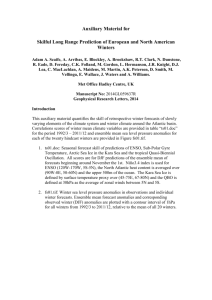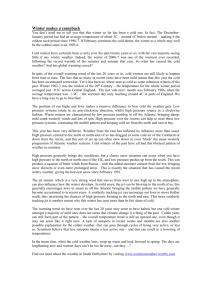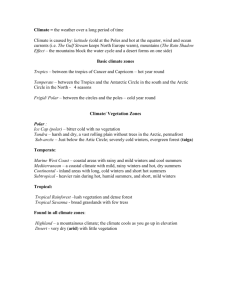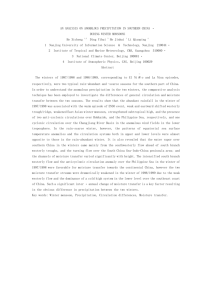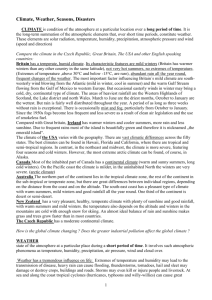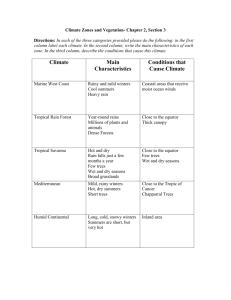Three-year winter package
advertisement
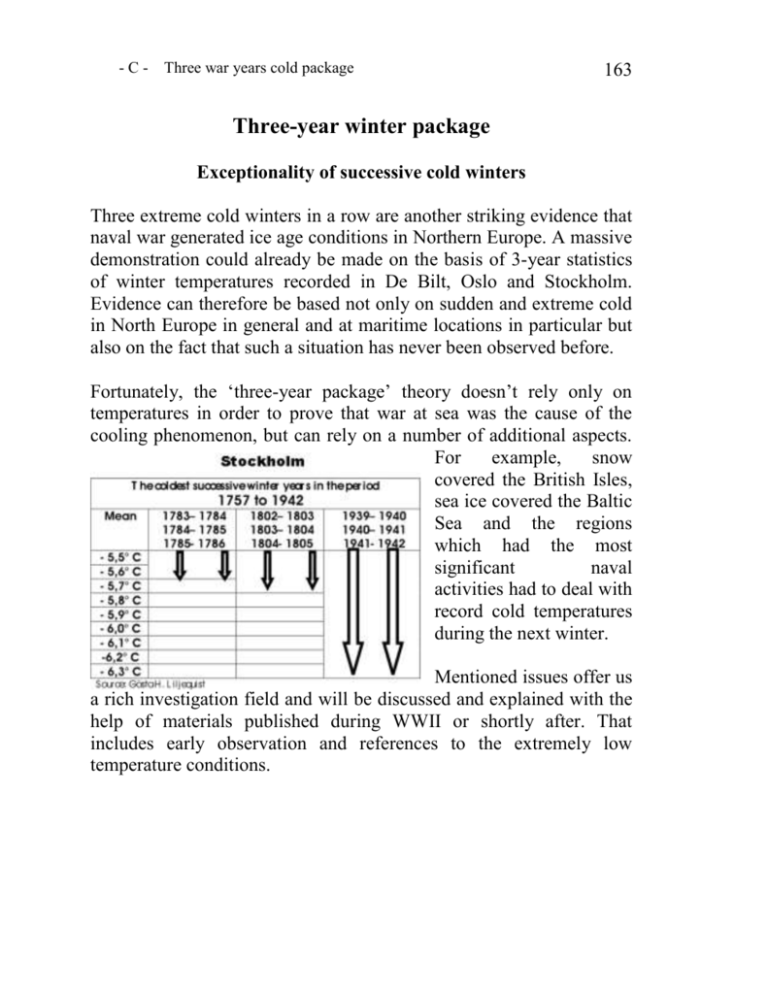
-C- Three war years cold package 163 Three-year winter package Exceptionality of successive cold winters Three extreme cold winters in a row are another striking evidence that naval war generated ice age conditions in Northern Europe. A massive demonstration could already be made on the basis of 3-year statistics of winter temperatures recorded in De Bilt, Oslo and Stockholm. Evidence can therefore be based not only on sudden and extreme cold in North Europe in general and at maritime locations in particular but also on the fact that such a situation has never been observed before. Fortunately, the ‘three-year package’ theory doesn’t rely only on temperatures in order to prove that war at sea was the cause of the cooling phenomenon, but can rely on a number of additional aspects. For example, snow covered the British Isles, sea ice covered the Baltic Sea and the regions which had the most significant naval activities had to deal with record cold temperatures during the next winter. Mentioned issues offer us a rich investigation field and will be discussed and explained with the help of materials published during WWII or shortly after. That includes early observation and references to the extremely low temperature conditions. -C- 164 Three war years cold package Low Temperatures Sweden As already indicated above, G. Liljequist observed: Three ice winters in succession are very rare139. During almost 200 years of weather observations at Stockholm, there are only two periods that came close to the most recent one in 1939-42. But none of the previous ‘threewinter-periods’ (calculated on the basis of mean temperature of three coldest months) had been as cold as the latter, which was 0.6°C colder than the next group of 1802-1805. Liljequist summarizes his results on Stockholm’s cold winters from 1757-1942 as it follows (excerpt): “Since the beginning of temperature observations, around 1760, up to the decade 1931-1940, mean winter temperatures have increased with about 2°C. This tendency is especially marked from the middle of the 19th century. The number of severe winters has decreased during recent years, while mild winters have remained rather constant in number”. Kew Observatory/UK Even during the „Cold Epoch“ (ca. 1810–1850), when 9 winters out of 42 were colder at Kew Observatory/UK than the 1939/40 “winter package”, none of these winters was so closely followed by subsequent cold winters as during the winters of 1939/40, 1940/41 and 1941/42140, which were furthermore commented upon: “The present century has been marked by such a widespread tendency towards mild winters that the ‘old-fashioned winters’, of which one had heard so much, seemed to have gone for ever. The sudden arrival, at the end of 1939, of what was to be the beginning of a series of cold winters was therefore all the more surprising. Since the winters of 1878/79, 139 Gösta Liljequist, Liljequist, Gösta H. (1941/42); ‚Isvintern 1941/42’; in: Staten Meteorologisk – Hydrograiska Anstalt, No.4, 1942, pp.2-15. 140 A.J. Drummond.; ‚Cold winters at Kew Observatory, 1783-1942’; Quarterly Journal of Royal Met. Soc., No. 69, 1943, pp 17-32, and: Drummond, A.J.; Discussion of the paper: ‚Cold winters at Kew Observatory, 1783-1942’; Quarterly Journal of Royal Met. Soc., 1943, p. 147ff. -C- Three war years cold package 165 1879/80 and 1880/81, there have never been three winters in a row as severe as those of 1939/40, 1940/41 and 1941/42.”141 Königsberg (Kaliningrad) as early as in war year 1944, F.B.Groissmeyer142 summarized temperature data according to three year intervals starting in 1853 until the third war winter 1941/42. The result is shown in the corresponding graph. Maritime and continental difference Before moving to the next issue, temperature differences between maritime and inland location, as mentioned in a previous chapter, should be included in a comprehensive ‘three year package’ list. While record cold winter results were achieved throughout North Europe, the difference between sea and land is remarkable. Land values for January and December were only slightly below previous record (Paris 1,2°C, Basel 0,1°C, and Wiesbaden managed only second place), while close-to-sea locations (De Bilt, Oslo and Stockholm) broke the previous cold records with extraordinary temperature differences from 1,6 to 2,7°C. This is strong evidence that North and Baltic Sea played a big role in generating the three arctic winters. While warm Atlantic water arrives in Europe as usually, colder North Sea water is recorded by the British weather reports. 141 A.J. Drummond, ditto, p. 31 142 Groissmayr, F.B (1944); ‘Die gewaltigen Temperaturestoerungen auf der Nordshemisphaere 1920-1942’, in: Zeitschrift fuer angewandte Meteorologie, Jg. 61, 1944, pp.15-56 (p. 55), (15-24, and 49-56). 166 -C- Three war years cold package This graph is a subsequent version of the graph on 138 (160), together with the given tables concerning seaside and inland record winter series (p.139/141). The record ‘three years series’ demonstrates two naval war impacts: That three successive record cold years happened in the first place; and That the excessive out performance of the previous coldest winter series by extraordinary 1,6 to 3 degrees Celsius at sea side location and compared to more inland location has its basis in too cold North and Baltic Sea water. Snow in Great Britain A snow-rich winter needs two conditions: abundant supply of aerial humidity, combined with cold air. During the war, Britain flouts like a battleship in a bath tube, filled with warm water and bathing water -C- Three war years cold package 167 steaming off. Cold continental air could quickly turn moisture air to fog, rain, ice-rain or snow. Extreme conditions came quickly. From the 27th of January to the 3rd of February 1940, England did not only face a tremendous snow problem but also experienced the longest-lasting ice-rain event, presumably the severest known. The most effected regions were from Wales, via south-westerly parts of Midlands, to SW and centralsouthern region. Meanwhile, violent stormy weather brought massive snow to south-eastern England, including snowdrifts reaching heights of 15 feet and more143. Surprised? Not really! Over the Atlantic, warm air clashed with cold air, which was actually colder than usually because of the naval warfare in the North and Baltic Seas. Kew Observatory In any case, snow in Britain is rare. In the south-east of England, snow can be expected only every 10th day. Any deviation should raise suspicion. During the winter 1939-1942, the rate per month was up to 400% higher. Drummond’s table showing percentage of days with snowfall is as it follows: 143 Cave, C.J.P.; ‚The ice storm of January 27-29, 1940’, and Discussion; Quarterly Journal of Royal Met. Soc., Vol. 66, No.285, 1940, pp.143-150. -C- 168 Year December 1939 –40 6% 1940-41 6% 1941 –42 3% Average(1871– 6% 1938) (Source: Drummond, see Fn. 18) January 32% 36% 42% 10% Three war years cold package February 24% 29% 46% 11% Dec.- Feb. 21% 23% 30% 9% The Isles Lewis144 made the following two statements concerning the snowcover in the British Isles, in the months of January and February of the severe winters of 1940, 1941 and 1942. “The three consecutive winters of 1940, 1941 and 1942 were, however, unusually severe; the snow was considerable and the number of days of snow-laying comparatively large”. “Three severe winters in succession like 1940, 1941 and 1942 seem to be without precedent in the British Isles for at least 60 years, a similar succession occurring from 1879-1881.” WWI and WWII At Kew Observatory, A.J. Drummond realised an exceptional situation in 1942145: “Since comparable records began in 1871, the only other three successive winters as snowy as the recent ones were those during the last war, namely 1915/16, 1916/17 and 1917/18, when snow fell on 23%, 48% and 23% of the days”. The naval warfare caused more humidity in the air and facilitated the inflow of cold continental air over The Isles, thus generating rain, ice-rain and snow in quantities which are above all statistical values. 144 Lewis, Lilian, F.; ‘Snow-cover in the British Isles in January and February of the severe winters 1940, 1941 and 1942’, in: Quarterly Journal of Royal Met. Soc., 1943, pp. 215-219. 145 A.J. Drummond, see Fn 18, p. 31 -C- Three war years cold package 169 Change of wind direction Norway Hesselberg & Birkeland146 point to significant climate deviations during the first three war years as reproduced in the following table: Means deviations for the Period 1940-42 from the mean values of the period 1901-30 Atmospheric pressure Winter Spring Summer Autumn +6 mb +3 mbar +0,5 mbar +0,5 mbar Air temp. -4°C -1°C +0,3°C precipitation - 12% - 8% +2% Wind from north +24% +8% +4% Wind from east -5% 0 0 Wind from south -17% -10% -6% Wind from west -1% +2% +2% Approximate figures for Southern Norway (Source: Hesselberg, Fn 24) +0,2°C +3% +7% -2% -9% +4% Hamburg/Germany - October 1939 That naval war in North and Baltic Sea reversed long-term climate data became obvious as early as October 1939, when the Deutsche Seewarte meteorologist on duty concluded in his analysis, on the 2nd of November 1939: “Hamburg reported winds from the North-Eastern quadrant on almost two thirds of the dates observed (33% easterly winds out of 65%) while north-eastern winds accounted only for a quarter (26%) of several previous years’ averages. Otherwise, most frequent direction of the wind – south-west (24%) – accounted for 9% of all cases. Thus the observations at this station alone show what the weather charts of an extensive area will obviously indicate as well.” 146 Hesselberg, TH., and Birkeland, B.J.; ‘The continuation of the secular variations of the climate of Norway 1940-50’, in: Geofysike publikasjoner Vol. XV. No.5, Bergen 1944-56; pp. 3-40. -C- 170 Three war years cold package Kew Observatory Everyone knows that Great Britain’s weather comes from the North Atlantic and the wind mostly from westerly directions. From prevailing wind directions in South-West England during 155 winters, from 1788 to 1942, only 21 had easterly resultants, whereby the few winters of 1814, 1841, and 1940 had resultants from NE to ENE. Another small number of winters since 1841 (1845, 1870, 1879, 1891, 1895, 1904, 1929) had prevailing winds from SSE to ESE. Except for the winters of 1801 and 1804, all these 21 winters with predominant easterly winds had temperatures below the average (40,1°F; 4,5°C). While eleven of the above winters had means between 34°F and 36°F, only six with westerly resultants had means lower than 37°F, these being 1820, 1830, 1847, 1855 and 1886147. Three ice winters in the Baltic Sea German coastal sea icing An accurate indicator of the severity of a winter in Baltic Sea and its bordering countries is the annual feature of icing. Considering the extent and severity of ice during the three war winters of 1939-42, it’s possible to provide ample proof that this extraordinary situation could only have been generated by intensive military use of these waters over the time period in question. Main aspects can be summarised as it follows: First and foremost, there is the suddenness and the severity of each of these ice winters, for which no other cause than the war at sea could be attributed. It is possible to establish a direct link between the extent of activities in the Baltic Sea and the degree of icing and of arctic winter conditions: 147 A.J. Drummond, see Fn. 18, p. 31 -C- Three war years cold package o o o 171 1939/40: intensive military activities, Gdansk, mining western Baltic and Gulf of Finland, Finnish-Russian war at sea resulted in very heavy ice. 1940/41: there were only general naval activities so the icing was less serious than that of the previous year. Yet, it was a severe ice winter. 1941/42: the Germans invaded Russia and fought with the Russian Baltic Fleet for five months, in the Central and the Northern Baltic Sea, during June-December 1941; this resulted in the most extended and heaviest icing ever observed. Another proof of great importance is the fact that there has never been such a severe icing. It should be noted that over the observation period the general mean temperatures in Sweden and in the Northern Hemisphere rose roughly with one degree, while the winter temperatures in Stockholm had risen with about 2°C since 1761. This comparison of extreme winter situations from the late 18th or early 19th century to similar events from the mid 20th century will make the latter appear even more severe and extraordinary. 172 -C- Three war years cold package Northern Baltic Sea icing Another important argument that nothing but the war at sea had turned the Baltic Sea into an ice age sea is the extent of the ice cover during the three years in question. According to a graph made by the Finnish Institute148, showing the ice cover in the Baltic Sea, 57° North latitude (ca. Visby - Riga latitude), there has never been one group of three successive years with such an important extent of ice cover as the ice phenomenon of the war years of 1939-1942 since 1720 (when such observations were recorded). As the graph provided by the Finnish Institute actually shows figures only since 1720, the ice cover during the winters of 1939-42 could have been the most extensive in many hundred years. From the whole period of more than 200 years, only 15 winters reached the highest possible ice volume, including those of 1939/40 and 1941/42. One of the reasons for this rarity of successive high ice coverage is presumably the fact that, from the moment the Baltic Sea reaches a high ice cover, the water body no longer transfers heat to the atmosphere; the deeper waters retaining, the more heat for the following winter season. But due to the intensive ‘stirring and mixing’ of the sea by military activities, a record ice coverage had been 148 Finnish Institute of Marine Research; M. Leppäranta et al.; “Phases of the ice season in the Baltic Sea’ No. 254, Suppl.2; Helsinki 1988 -C- Three war years cold package 173 achieved in the Baltic Sea during the three war years 1939-42, which actually was inevitable. There is virtually no other explanation available. Centers of record winters It is interesting to observe that certain regions reported record climatic events, on one hand, while, on the other hand, they saw intensive military activities ‘close by’. 1939/40: Germany reported a record cold winter. In fact, heavy mining, fighting (e.g. Gdansk), military surveillance, transport and exercises took place in the coastal waters of the Baltic Sea, during prewinter months. 1940/41: Norway claimed to have recorded low temperatures as never measured before at a number of stations in southern Norway immediately after the Germans invaded Norway in the summer, and mine warfare and fighting continued along its coast and heavy ship movements took place between Germany and Norway thereafter. 1941/42: Middle Sweden149, Denmark150 and The Netherlands151 claimed the coldest winter in more than 130 years; after the German 149 Gösta Liljequist, see: Fn.17 150 Det Danske Metorologiske Institut; ‘Is- og besejlingsforholdene i de danske Farvande in Vinteren 1939-40; 1940-41; 1941-42; 1947, Kobenhavn. 151 At De Bilt (data series 1706-1993) January and February 1942 had been –7,9°C colder than 1941, and –2,4°C colder than 1940. The long-term average is well above zero (about +5°C) 174 -C- Three war years cold package invasion of Russia, codenamed ‘Barbarossa’ brought heavy fighting to the Baltic countries, from June to December. All mentioned locations claimed the third winter of 1941/42 as the coldest, leaving to the first war winter 1939/40 ‘only’ a second place, during a time period of 100 years and more. The centre of the cold was ‘in the middle of the Baltic and North Sea, somewhere between Hamburg and Skagen/Denmark. Summary If we look for the reasons of the sudden arrival of arctic winters in the same time with the naval war in North-European waters, chosen and applied statistic prove convincingly that war at sea prepared the ‘ground’ for dragging arctic air into Europe, to Atlantic shores. This investigation observed latter conditions with care because there is no change without a cause. The three arctic war winters 1939-1942 are no exception. At a global level, the law of physics binds people, air and sea. Any hot soup stirred lets steam off and cools down. Any warm lake, sea or ocean, which is churned and stirred during winter season, lets off steam and the summer-warm sea surface layer cools down quickly. The mechanism is simple and the result, obvious. One can only wonder why science pays no interest to this matter and remains silent on the issue of the WWII winter. Only four months after WWII commenced, North Europe’s winter was back to icy conditions last experienced during the ‘Cold Epoch’, more than 100 years ago. Two extreme winters followed during the naval warfare, which was fought in the North European, waters and in other waters adjacent to them. Nothing is completely explained yet. Conducting a war is devastating but not chaotic to such a huge extent. Three cold winters were the logical consequence of war at sea in sensitive waters. Ending a series of three arctic winters (1939-1942) was only “natural” after Japan had dragged the United States into war, on the 7th of December 1941, and naval warfare went global on an unprecedented scale. A temporary regional cooling impact became a worldwide phenomenon for four decades.
